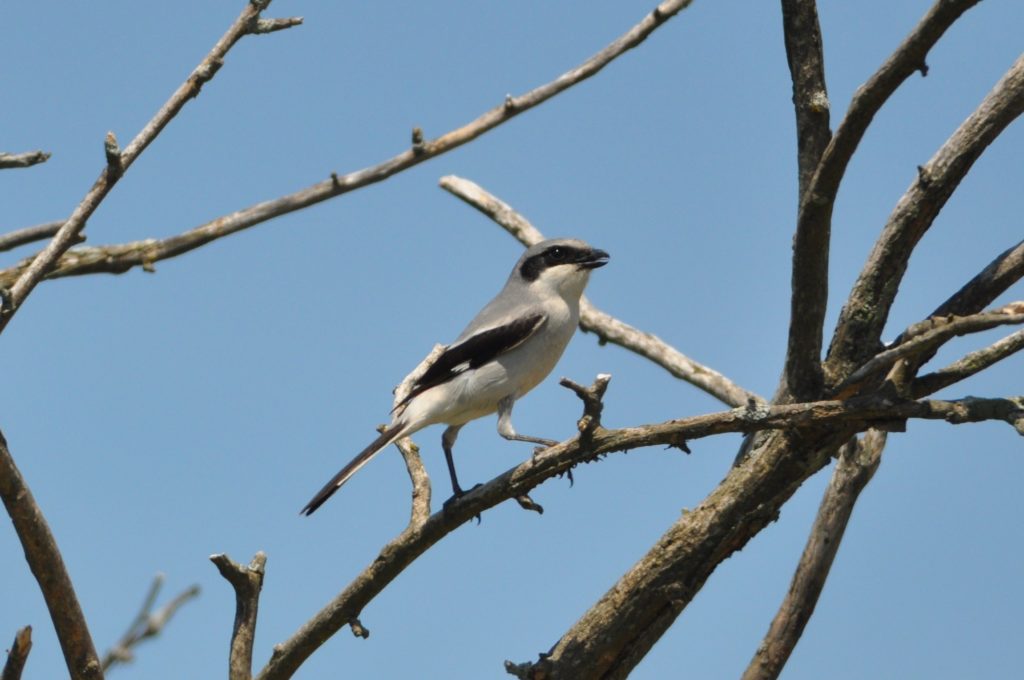
Often referred to as the “butcher bird,” the Loggerhead Shrike (Lanius ludovicianus) is most known for impaling prey on thorns, branches, or barbed wire. However, this Virginia-native songbird is in decline. Potential reasons for their decline include excessive pesticide use, collisions with vehicles, adverse weather conditions, disease, and habitat loss. In collaboration with the Virginia Department of Game and Inland Fisheries, West Virginia Department of Natural Resources, Smithsonian Conservation Biology Institute (SCBI), and Wildlife Preservation Canada (WPC), VWL conducts research to better understand the causes of decline, and develop strategies to mitigate them.
VWL assists with inventorying and monitoring wild populations of Shrikes and their habitat in Virginia and West Virginia. Furthermore, we assist with banding of individuals to better understand movement patterns and site fidelity, and collect genetic samples to determine population health and connectivity. Monitoring our banded birds revealed that multiple individuals use the same sites throughout the year. Prior to banding, it was assumed these were the same birds occupying sites year-round. VWL will continue banding and population monitoring in 2018 and beyond.
As a part of the Loggerhead Shrike Working Group, VWL is developing monitoring protocols for citizen scientists working throughout the Loggerhead Shrike’s entire range. Data collected from these efforts will be used to identify critical knowledge gaps in Loggerhead Shrike breeding success and habitat use.
VWL used field data, submitted to eBird, to create an occupancy model which predicts Loggerhead Shrike occurrences in the southeastern US. Our models suggest that they prefer open country habitat and avoid harsh weather. In forests, there may be a tradeoff between predation risk and increased cover from winter weather. If you spot a banded or un-banded Loggerhead Shrike in Virginia, please report your sighting(s) to dgifweb@dgif.virginia.gov!
In addition to these research efforts, WPC and the Center for Species Survival at SCBI are establishing a captive breeding population of Loggerhead Shrikes. They have already successfully released several captive birds in the wild!
The Animal Care team at SCBI assists with health and fitness assessments of wild and captive Loggerhead Shrikes. Data collected will provide baseline health information on wild populations and improve veterinary care for captive breeding populations.
Publications:
- Tiny, fierce and disappearing: breeding program aims to help the loggerhead shrike
- SCBI’s Loggerhead Shrikes Released in Canada
Collaborators and Primary Investigators:
- Amy Johnson – Virginia Working Landscapes
- Warren Lynch – SCBI
- Virginia Department of Game & Inland Fisheries
- West Virginia Division of Natural Resources
- Wildlife Preservation Canada
SUPPORT VWL
VWL is supported 100% by grants and donations and our work is made possible by the generous contributions from our community.
The Smithsonian Institution is a 501(c)(3). All contributions are tax-deductible.
GET IN TOUCH
Virginia Working Landscapes
Smithsonian’s National Zoo and Conservation Biology Institute
1500 Remount Road, MRC 5537
Front Royal, Virginia 22630
SCBIVWL@si.edu
540-635-0035
